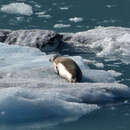Biology
provided by World Register of Marine Species
Harbour seals are good swimmers. The pinipeds serve as rudder. The body and back pinnipeds cause propulsion. The seal is highly adapted to speed with its torpedo-like body and pinna. Observations made from ships revealed that they generally swim just 10 m beneath the water surface and that only rarely will they hunt under –20 m. Young harbour seals are born on tide-sandbanks between the end of June and mid July, and are required, almost immediately (during high-tide) to be able to swim. In general, harbour seals feed on benthic fish (such as flounder, sole, cod and whiting), but they must largely be quite opportunistic in regard to what they eat. They may also feed on mussels, crabs and cephalopods.
Stienen, E.W.M.; Van Waeyenberge, J.; Kuijken, E. (2003). Zeezoogdieren in Belgisch mariene wateren [Marine mammals in Belgian marine waters]. Rapport Instituut voor Natuurbehoud, A.2003.152. Instituut voor Natuurbehoud: Brussel, Belgium. 15 pp.
- license
- cc-by-4.0
- copyright
- WoRMS Editorial Board
Diet
provided by World Register of Marine Species
Fish, crustaceans, squid
North-West Atlantic Ocean species (NWARMS)
- license
- cc-by-4.0
- copyright
- WoRMS Editorial Board
Distribution
provided by World Register of Marine Species
North America
North-West Atlantic Ocean species (NWARMS)
- license
- cc-by-4.0
- copyright
- WoRMS Editorial Board
Habitat
provided by World Register of Marine Species
temperate to polar
van der Land, J. (ed). (2008). UNESCO-IOC Register of Marine Organisms (URMO).
- license
- cc-by-4.0
- copyright
- WoRMS Editorial Board
Habitat
provided by World Register of Marine Species
nearshore waters of the Atlantic Ocean and adjoining seas above about 30 degrees latitude
North-West Atlantic Ocean species (NWARMS)
- license
- cc-by-4.0
- copyright
- WoRMS Editorial Board
Morphology
provided by World Register of Marine Species
Distinguishing Characteristics: small in size in relation to seals, dog-like face, v-shaped nostrils, colour varies from white to tan to dark brown to red (molttled):
North-West Atlantic Ocean species (NWARMS)
- license
- cc-by-4.0
- copyright
- WoRMS Editorial Board
Morphology
provided by World Register of Marine Species
Harbour seals can reach up to 1.6 m in length and weigh about 120 kilos. Their colour varies from grey to brown with black marks. A characteristic feature is their V-shaped nostrils.
Stienen, E.W.M.; Van Waeyenberge, J.; Kuijken, E. (2003). Zeezoogdieren in Belgisch mariene wateren [Marine mammals in Belgian marine waters]. Rapport Instituut voor Natuurbehoud, A.2003.152. Instituut voor Natuurbehoud: Brussel, Belgium. 15 pp.
- license
- cc-by-4.0
- copyright
- WoRMS Editorial Board

